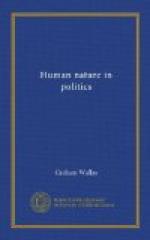‘Excepting,’ he says, ’the degree of uncertainty, which still exists as to the extent of the natural differences of individual minds, and the physical circumstances on which these may be dependent, (considerations which are of secondary importance when we are considering mankind in the average or en masse), I believe most competent judges will agree that the general laws of the different constituent elements of human nature are even now sufficiently understood to render it possible for a competent thinker to deduce from those laws, with a considerable approach to certainty, the particular type of character which would be formed, in mankind generally, by any assumed set of circumstances.’[39]
[39] System of Logic, Book vi. vol. ii. (1875), p. 462.
Few people nowadays would be found to share Mill’s belief. It is just because we feel ourselves unable to deduce with any ’approach to certainty’ the effect of circumstances upon character, that we all desire to obtain, if it is possible, a more exact idea of human variation than can be arrived at by thinking of mankind ’in the average or en masse.’
Fortunately the mathematical students of biology, of whom Professor Karl Pearson is the most distinguished leader, are already showing us that facts of inherited variation can be so arranged that we can remember them without having to get by heart millions of isolated instances. Professor Pearson and the other writers in the periodical Biometrika have measured innumerable beech leaves, snails’ tongues, human skulls, etc. etc., and have recorded in each case the variations of any quality in a related group of individuals by that which Professor Pearson calls an ‘observation frequency polygon,’ but which I, in my own thinking, find that I call (from a vague memory of its shape) a ‘cocked hat.’
Here is a tracing of such a figure, founded on the actual measurement of 25,878 recruits for the United States army.
[Illustration: [Transcriber’s Description: A line graph of number of recruits vs. height. The horizontal axis is AC, and the line itself is ABC, which is roughly normal.]]
The line ABC records, by its distance at successive points from the line AC, the number of recruits reaching successive inches of height. It shows, e.g. (as indicated by the dotted lines) that the number of recruits between 5 ft. 11 in. and 6 ft. was about 1500, and the number of those between 5 ft. 7 in. and 5 ft. 8 in. about 4000.[40]
[40] This figure is adapted (by the kind permission of the publishers) from one given in Professor K. Pearson’s Chances of Death, vol. i. p. 277. For the relation between such records of actual observation and the curves resulting from mathematical calculation of known causes of variation, see ibid., chap, viii., the paper by the same author on ‘Contributions to the Mathematical Theory of Evolution,’ in vol. 186 (A) of the Royal Society’s Philosophical Transactions (1896), and the chapters on evolution in his Grammar of Science, 2nd edition.




